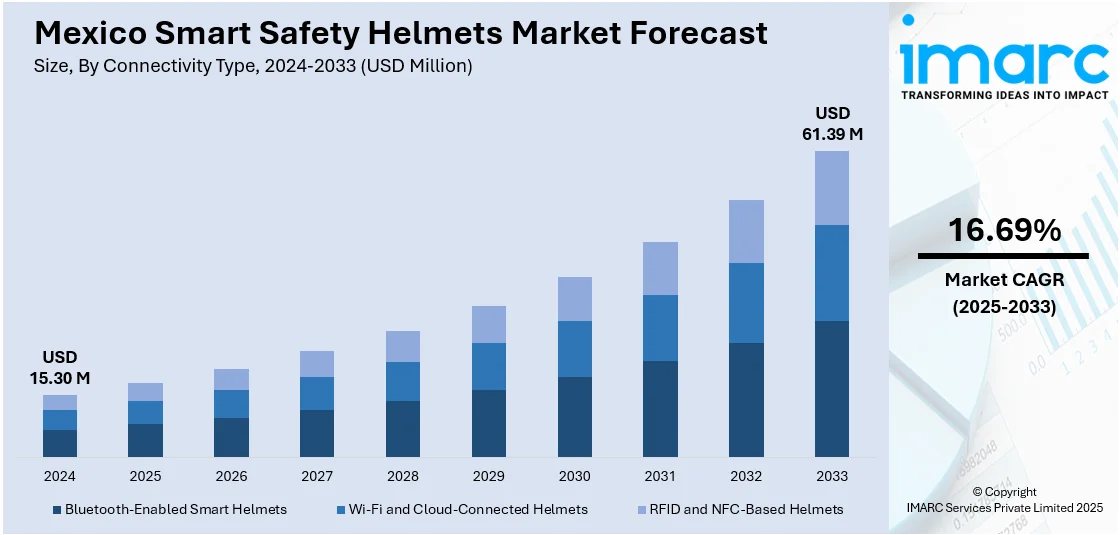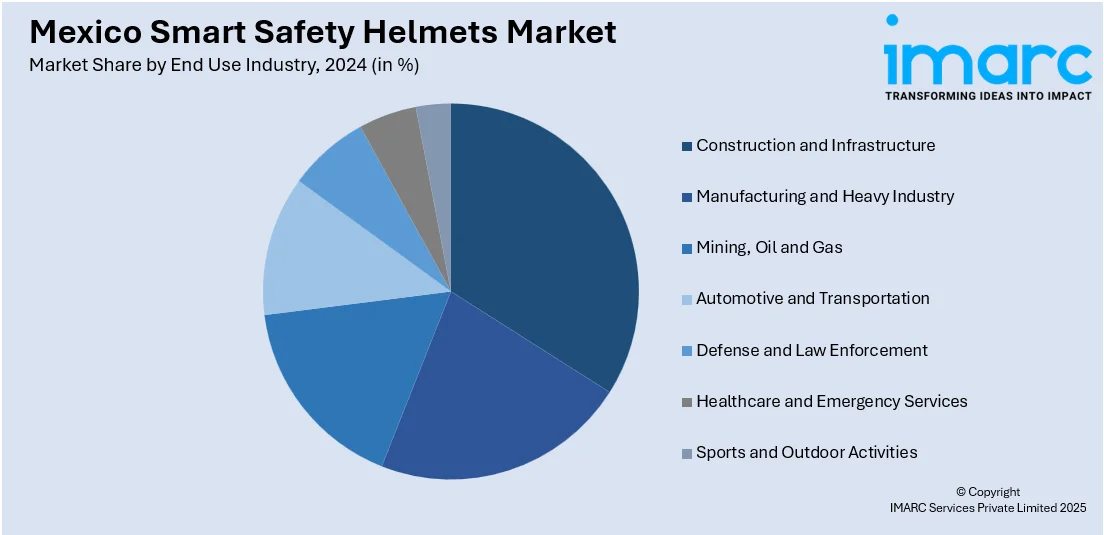
Mexico Smart Safety Helmets Market Size, Share, Trends and Forecast by Technology Type, Connectivity Type, Material Type, Safety Features, End Use Industry, and Region, 2025-2033
Mexico Smart Safety Helmets Market Overview:
The Mexico smart safety helmets market size reached USD 15.30 Million in 2024. Looking forward, IMARC Group expects the market to reach USD 61.39 Million by 2033, exhibiting a growth rate (CAGR) of 16.69% during 2025-2033. The market is witnessing significant growth due to increasing workplace safety regulations, rising adoption of wearable technology, and demand from high-risk sectors like construction, mining, and oil & gas. Real-time monitoring, impact detection, and integrated communication tools are also gaining traction. Government focus on industrial safety and digital transformation is further contributing to the overall Mexico smart safety helmets market share.
|
Report Attribute
|
Key Statistics
|
|---|---|
|
Base Year
|
2024 |
|
Forecast Years
|
2025-2033
|
|
Historical Years
|
2019-2024
|
| Market Size in 2024 | USD 15.30 Million |
| Market Forecast in 2033 | USD 61.39 Million |
| Market Growth Rate 2025-2033 | 16.69% |
Mexico Smart Safety Helmets Market Trends:
Growing Demand for AR and HUD Features
The growing demand for Augmented Reality (AR) and Heads-Up Display (HUD) features is shaping the future of the Mexico Smart Safety Helmets Market. AR-integrated helmets allow workers to access critical data overlays in real-time without diverting attention from their tasks, enhancing both safety and efficiency. In industries such as construction, energy, and manufacturing, these helmets are being used for remote troubleshooting, enabling off-site experts to provide live guidance through video feeds. HUD features display essential metrics—such as temperature, structural layouts, and instructions—directly in the worker’s line of sight, reducing reliance on handheld devices or printed manuals. This hands-free access to contextual information improves decision-making and reduces operational delays. Virtual training modules embedded within AR systems also allow for immersive, scenario-based learning experiences on-site. As industrial operations in Mexico grow more complex, these smart capabilities are becoming integral to modern safety protocols and workforce training programs.

Rising Adoption in Construction and Mining
Construction and mining are among the most hazardous industries in Mexico, and they are rapidly embracing smart safety helmets to improve worker protection and operational visibility. These sectors face risks such as falling objects, gas leaks, and structural failures, prompting the adoption of helmets equipped with features like impact detection, real-time location tracking, and environmental monitoring. In mining operations, smart helmets help supervisors track worker positions underground, monitor air quality, and ensure timely responses during emergencies. In construction, the use of smart helmets facilitates communication between dispersed teams, ensures compliance with safety protocols, and supports on-site training through integrated AR tools. Government efforts to strengthen occupational safety standards and companies' focus on reducing workplace incidents are further driving implementation. This shift toward intelligent safety solutions is significantly contributing to Mexico smart safety helmets market growth across large infrastructure and extractive industry projects.
Integration of Real-Time Monitoring
The integration of real-time monitoring features in smart safety helmets is becoming a key advancement in Mexico’s industrial safety landscape. These helmets are embedded with sensors that continuously track worker health metrics such as heart rate, body temperature, and fatigue levels, helping detect early signs of physical stress or overexertion. Environmental sensors monitor variables like gas concentrations, temperature, humidity, and noise levels, offering alerts before conditions become hazardous. This proactive approach enables supervisors to intervene promptly, reducing the likelihood of accidents and health incidents on-site. Real-time data is transmitted to centralized systems for immediate analysis and long-term safety planning. Industries such as oil and gas, manufacturing, and logistics are particularly benefiting from these features. As safety protocols evolve and digitization becomes central to operations, real-time monitoring is emerging as a critical function, supporting both worker welfare and overall operational reliability.
Mexico Smart Safety Helmets Market Segmentation:
IMARC Group provides an analysis of the key trends in each segment of the market, along with forecasts at the country and regional levels for 2025-2033. Our report has categorized the market based on technology type, connectivity type, material type, safety features, and end use industry.
Technology Type Insights:
- IoT-Enabled Smart Helmets
- Augmented Reality (AR) and Heads-Up Display (HUD) Helmets
- AI-Powered Safety Helmets
- Sensor-Based Smart Helmets
- GPS-Enabled Helmets
- Communication-Integrated Helmets
The report has provided a detailed breakup and analysis of the market based on the technology type. This includes IoT-enabled smart helmets, augmented reality (AR) and heads-up display (HUD) helmets, AI-powered safety helmets, sensor-based smart helmets, GPS-enabled helmets, and communication-integrated helmets.
Connectivity Type Insights:
- Bluetooth-Enabled Smart Helmets
- Wi-Fi and Cloud-Connected Helmets
- RFID and NFC-Based Helmets
A detailed breakup and analysis of the market based on the connectivity have also been provided in the report. This includes Bluetooth-enabled smart helmets, Wi-Fi and cloud-connected helmets, and RFID and NFC-based helmets.
Material Type Insights:
- Polycarbonate Helmets
- Fiberglass and Composite Helmets
- ABS Plastic Helmets
- Carbon Fiber Helmets
A detailed breakup and analysis of the market based on the material type have also been provided in the report. This includes polycarbonate helmets, fiberglass and composite helmets, ABS plastic helmets, and carbon fiber helmets.
Safety Features Insights:
- Real-Time Health Monitoring
- Fall and Impact Detection
- Noise Cancellation and Communication Enhancement
- Fire and Hazard Detection
- Environmental Monitoring
- Smart Lighting and Alerts
A detailed breakup and analysis of the market based on the safety features have also been provided in the report. This includes real-time health monitoring, fall and impact detection, noise cancellation and communication enhancement, fire and hazard detection, environmental monitoring, and smart lighting and alerts.
End Use Industry Insights:

- Construction and Infrastructure
- Manufacturing and Heavy Industry
- Mining, Oil and Gas
- Automotive and Transportation
- Defense and Law Enforcement
- Healthcare and Emergency Services
- Sports and Outdoor Activities
A detailed breakup and analysis of the market based on the end use industry have also been provided in the report. This includes construction and infrastructure, manufacturing and heavy industry, mining, oil and gas, automotive and transportation, defense and law enforcement, healthcare and emergency services, and sports and outdoor activities.
Regional Insights:
- Northern Mexico
- Central Mexico
- Southern Mexico
- Others
The report has also provided a comprehensive analysis of all the major regional markets, which include Northern Mexico, Central Mexico, Southern Mexico, and Others.
Competitive Landscape:
The market research report has also provided a comprehensive analysis of the competitive landscape. Competitive analysis such as market structure, key player positioning, top winning strategies, competitive dashboard, and company evaluation quadrant has been covered in the report. Also, detailed profiles of all major companies have been provided.
Mexico Smart Safety Helmets Market Report Coverage:
| Report Features | Details |
|---|---|
| Base Year of the Analysis | 2024 |
| Historical Period | 2019-2024 |
| Forecast Period | 2025-2033 |
| Units | Million USD |
| Scope of the Report | Exploration of Historical Trends and Market Outlook, Industry Catalysts and Challenges, Segment-Wise Historical and Future Market Assessment:
|
| Technology Types Covered | IoT-Enabled Smart Helmets, Augmented Reality (AR) and Heads-Up Display (HUD) Helmets, AI-Powered Safety Helmets, Sensor-Based Smart Helmets, GPS-Enabled Helmets, Communication-Integrated Helmets |
| Connectivity Types Covered | Bluetooth-Enabled Smart Helmets, Wi-Fi and Cloud-Connected Helmets, RFID and NFC-Based Helmets |
| Material Types Covered | Polycarbonate Helmets, Fiberglass and Composite Helmets, ABS Plastic Helmets, Carbon Fiber Helmets |
| Safety Features Covered | Real-Time Health Monitoring, Fall and Impact Detection, Noise Cancellation and Communication Enhancement, Fire and Hazard Detection, Environmental Monitoring, Smart Lighting and Alerts |
| End Use Industries Covered | Construction and Infrastructure, Manufacturing and Heavy Industry, Mining, Oil and Gas, Automotive and Transportation, Defense and Law Enforcement, Healthcare and Emergency Services, Sports and Outdoor Activities |
| Regions Covered | Northern Mexico, Central Mexico, Southern Mexico, Others |
| Customization Scope | 10% Free Customization |
| Post-Sale Analyst Support | 10-12 Weeks |
| Delivery Format | PDF and Excel through Email (We can also provide the editable version of the report in PPT/Word format on special request) |
Key Questions Answered in This Report:
- How has the Mexico smart safety helmets market performed so far and how will it perform in the coming years?
- What is the breakup of the Mexico smart safety helmets market on the basis of technology type?
- What is the breakup of the Mexico smart safety helmets market on the basis of connectivity type?
- What is the breakup of the Mexico smart safety helmets market on the basis of material type?
- What is the breakup of the Mexico smart safety helmets market on the basis of safety features?
- What is the breakup of the Mexico smart safety helmets market on the basis of end use industry?
- What is the breakup of the Mexico smart safety helmets market on the basis of region?
- What are the various stages in the value chain of the Mexico smart safety helmets market?
- What are the key driving factors and challenges in the Mexico smart safety helmets market?
- What is the structure of the Mexico smart safety helmets market and who are the key players?
- What is the degree of competition in the Mexico smart safety helmets market?
Key Benefits for Stakeholders:
- IMARC’s industry report offers a comprehensive quantitative analysis of various market segments, historical and current market trends, market forecasts, and dynamics of the Mexico smart safety helmets market from 2019-2033.
- The research report provides the latest information on the market drivers, challenges, and opportunities in the Mexico smart safety helmets market.
- Porter's five forces analysis assist stakeholders in assessing the impact of new entrants, competitive rivalry, supplier power, buyer power, and the threat of substitution. It helps stakeholders to analyze the level of competition within the Mexico smart safety helmets industry and its attractiveness.
- Competitive landscape allows stakeholders to understand their competitive environment and provides an insight into the current positions of key players in the market.
Need more help?
- Speak to our experienced analysts for insights on the current market scenarios.
- Include additional segments and countries to customize the report as per your requirement.
- Gain an unparalleled competitive advantage in your domain by understanding how to utilize the report and positively impacting your operations and revenue.
- For further assistance, please connect with our analysts.
 Request Customization
Request Customization
 Speak to an Analyst
Speak to an Analyst
 Request Brochure
Request Brochure
 Inquire Before Buying
Inquire Before Buying




.webp)




.webp)












